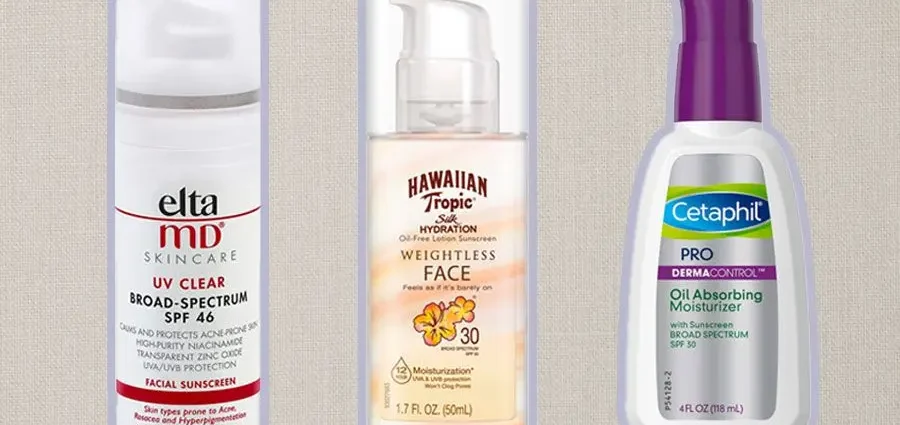Contents
In the heat, those who suffer from acne become one more problem: how to protect yourself from the sun and at the same time not provoke new pimples and comedones? We know how to find a way out of this situation.
The effect of the sun on problem skin
And now we can say with confidence that exposing an unprotected face to the active sun is a bad idea.
UV exposure worsens acne-prone skin.
Indeed, at first, ultraviolet light dries out pimples, visually improving the condition of the skin with acne. However, do not flatter yourself: the drying effect is due to the dryness of the epidermis, which inevitably occurs during insolation. As a result, the skin will try to compensate for the lack of moisture with increased production of sebum, and the long-awaited vacation at sea can turn into a new round of the fight against acne and pimples.
The need for sun protection
Skin with acne, unlike, for example, just oily skin, constantly suffers from inflammation, which means that its immunity is weakened and its own reserves that allow it to withstand ultraviolet stress are not enough.
Therefore, dermatologists recommend protecting acne-prone skin with a sunscreen with a maximum protection factor of 50+.
Rules for choosing sunscreen for skin with acne
Owners of oily, and even more problematic skin have to be extremely selective in choosing sunscreen. After all, with a tendency to acne, you are more likely to completely refuse protection than to apply a heavy, uncomfortable remedy on your face that provokes oily sheen and clogged pores. So cosmetics manufacturers need to work hard to create a sunscreen for super-demanding skin.
Owners of problem skin are selective in the choice of cosmetics.
Materials
The ideal sunscreen for acne-prone skin has the following characteristics:
contains SPF 50+;
has a light texture (fluid, emulsion, gel, cream-gel);
does not provoke oily sheen;
does not clog pores;
does not leave a feeling of stickiness;
provides a matting effect;
prevents acne and pigmentation after exposure to the sun;
fights existing imperfections.
Composition
The first rule is the absence of comedogenic ingredients that can cause clogged pores. These components include:
mineral oils;
petrolatum;
paraffin;
vegetable oils (coconut, olive, palm);
acids (stearic, palmetic, oleic);
titanium dioxide (mineral sunscreen), which clogs pores at high concentration.
In the sunscreen formula for problematic skin, in addition to broad-spectrum filters (from UVB and UVA rays), which protect against burns and prevent early skin aging, the following components are very appropriate:
sebum-regulating;
exfoliating, for example, acids;
antiseptic;
soothing.
Texture
The lighter the texture of the sunscreen, the faster it absorbs, the more comfortable the remedy for problematic oily skin. The task of cosmetics manufacturers is to combine effective sun protection with the most light and comfortable consistency.
New sunscreen for problem skin
At the moment, Healthy-Food is ready to name the best way to protect problem skin from ultraviolet radiation sunscreen gel for oily and acne-prone skin, SPF 50+ / PPD 21, Anthelios, La Roche-Posaybecause it meets all the necessary requirements.
Advantages
XL-PROTECT™ technology, which combines patented photostable filters with antioxidants, protects against UVA and UVB rays and neutralizes free radicals, including those generated by infrared radiation.
Airlicium™ technology provides a mattifying effect and controls the sources of shine (sweat, sebum).
Salicylic acid and niacinamide help fight existing acne and prevent new ones from sun exposure.
La Roche-Posay Thermal Water soothes, softens and helps protect the skin from the negative effects of free radicals thanks to its selenium content.
Cream-gel has a light non-greasy texture, waterproof, does not whiten the skin. The formula is hypoallergenic, fragrance-free, non-comedogenic.
application method
Take a look at some helpful tips.
Cream-gel can be used not only during a beach holiday, but also daily for sun protection in the city.
The product is generously applied to the skin of the face (avoiding the area around the eyes) before going outside / beach.
This sunscreen can be used with your usual skin care products or on its own.
There are no strict rules for using the product: it can be applied both before makeup and on top of it.
Remember to renew your protection regularly while out in the sun. And, of course, after bathing and drying with a towel.
For more information on how to use sunscreen, read our articles. See if you know how to properly apply sunscreen.










